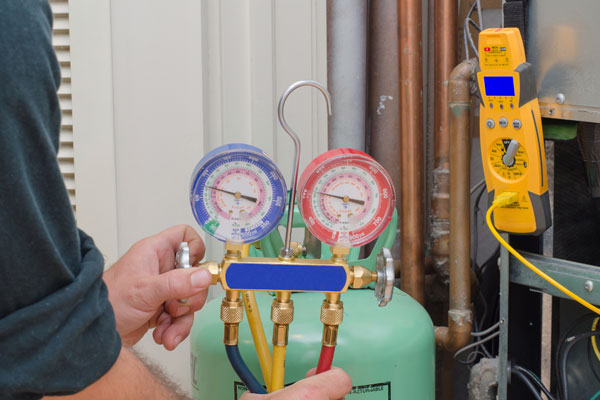HVAC Refrigerant: What Changes in 2025

New HVAC Refrigerant Changes Will Happen in 2025
The new air conditioner models have arrived, and they contain a new brand of refrigerant. All new systems will use either R-32 or R-454B HVAC Refrigerant, replacing the older R-410A version. It might seem like a great bother until you understand the purpose of these refrigerants.
Air conditioners and heat pumps use a principle called heat transfer, illustrated by an ordinary popsicle. Immediately after removing the popsicle from the freezer, the popsicle begins to melt; heat seems to be attracted to a cold object like a magnet.
Heat transfer uses this principle to move heat from inside a home to the outside for air conditioning and moving heat from outside to the inside in the heat pump mode. But to move enough heat to change the temperature in an entire house requires a better magnet than a popsicle.
Air conditioning engineers have discovered a series of chemicals that transfer heat very efficiently and have termed the compounds “refrigerants.” These large molecules readily change state, between liquid and gas, a process we know as evaporation. Compressing the gas and suddenly releasing it creates a rapid drop in temperature, which in turn becomes the heat magnet. So, why are these chemicals changing?
Refrigerants are chlorofluorocarbons (CFCs) and are considered environmentally problematic. Although they are nontoxic and nonflammable, they hurt the Earth’s ozone layer by reacting with ozone. Ozone creates a barrier to the Sun’s ultraviolet radiation—the rays that cause sunburns.
While the refrigerants are kept in a closed loop of pipes and components, the gas is put under great pressure. That means the network is susceptible to the development of minute gaps, allowing the gas to quickly escape.
For this reason, engineers are constantly seeking new formulas to achieve greater energy efficiency and reduced environmental risk. These refrigerants have names that designate their chemical formula, which means very little to the average homeowner.
- R-22 HVAC Refrigerant was very efficient but significantly more environmentally hazardous. It was replaced by R-410A.
- The US Environmental Protection Agency makes these changes gradually and strategically. Manufacturers knew that R-410A would be discontinued in new HVAC systems by January 2025, and this decision was made in 2021. This change was planned and is not a surprise.
- Two new HVAC Refrigerants have been prepared, both with lower environmental impact.
New HVAC systems will be slightly more expensive but for an unusual reason. Both R-32 and R-454B are slightly flammable. Since the refrigerant is contained in a closed network, the chance of ignition is extremely low. However, since a potentially flammable gas is stored close to ignition sources, the systems are designed with redundant safety features in an abundance of caution. Additional sensors are in place for added protection.
Existing HVAC systems using R-410A will continue to function: well-maintained systems often last for 20 to 25 years. No worries, this HVAC Refrigerant will still be available for years to come, ensuring repairs and refrigerant replacement can continue. Eventually, as old systems are replaced, the need for a supply of R-410A will decline and the available supply will become very expensive. But that is years down the road.
New systems will utilize the new refrigerants. And that is good since both R-32 and R-454B are more energy-efficient than the existing R-410A and are better for our environment. Replacing an HVAC system will have dual advantages.
Is your HVAC system using an older HVAC Refrigerant?
Houston Trane can connect you with a Trane Licensed AC Contractor who can answer your questions about HVAC Refrigerant. To find a local Trane AC Contractor, visit our Local Dealer search tool.